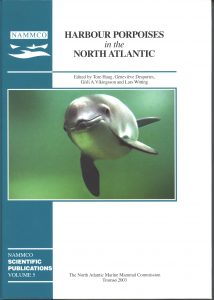Volume 5: Harbour porpoise
Harbour porpoises in the North Atlantic
The harbour porpoise (Phocoena phocoena) is one of the most familiar cetaceans, widely distributed in both the Pacific and Atlantic parts of the northern hemisphere, in coastal and continental shelf waters. Beached specimens are frequently found in some areas and have been the subject of many anatomical studies. However, the general biology and ecology of the species is still not very well understood, in part because their small size and elusive behaviour make harbour porpoises difficult to study in the wild. It became clear at the end of the 1980s that considerable numbers of harbour porpoises were being bycaught in fishing gear, especially bottom set gillnets, in every part of their distributional range. When available, reliable information on population size and bycatch levels showed that levels of bycatch were large enough to justify concern about sustainability.
In addition to the direct threat from incidental bycatches, harbour porpoises may face pressure due to depletion of prey stocks through overfishing, pollution, which may cause suppression of the immune system and reduce reproductive success, and disturbances of vital habitat.
At the 7th meeting of the NAMMCO Council (Torshavn, the Faroes in 1997) it was noted that the harbour porpoise is common to all NAMMCO member countries (Norway, the Faroes, Iceland, Greenland), and that the extent of current research activities and expertise in member countries and elsewhere across the North Atlantic would provide an excellent basis for undertaking a comprehensive assessment of the species throughout its range. The Scientific Committee was, therefore, requested to perform such an assessment, including distribution and abundance, stock identity, biological parameters, ecological interaction, pollutants, removals and sustainability of removals. The Scientific Committee decided that the matter could best be dealt with by convening an international workshop/symposium on harbour porpoises, which would involve experts working on this species throughout its North Atlantic range.
The International Symposium on Harbour Porpoises in the North Atlantic was held on board the Norwegian Coastal Steamer MS Nordlys enroute from Bergen to Tromsø, September 10-14, 1999. It was attended by 31 delegates and included 22 presentations. The Symposium agenda was structured around four theme sessions, each led and chaired by an invited keynote speaker. The keynote speakers also had the responsibility of summarising the discussions around their respective themes, and synthesising conclusions and recommendations. These were presented and discussed on the final day of the Symposium. A full report of the Symposium was distributed to all participants, and was published in the NAMMCO Annual Report 2000. This volume consists mainly of papers that were presented at the Symposium, but also includes other contributions. Because of the length of time that has elapsed between the Symposium and the publication of this volume, all contributions have been updated to reflect current findings.
The contributions presented in this volume serve to illustrate the state of art with regard to management relevant aspects of the biology and status of harbour porpoises in the North Atlantic. We feel that the volume extends the efforts already taken by the IWC Scientific Committee and other organisations such as ASCOBANS and ICES, and particularly adds new information from areas poorly covered in previous reports.
This volume is edited by: Tore Haug, Principal Scientist, Institute of Marine Research, Tromsø, Norway; Geneviève Desportes, Head of the Marine Mammal and Research Department, Fjord & Bælt, Kerteminde, Denmark; Gísli Víkingsson, Senior Scientist at the Marine Research Institute, Reykjavik, Iceland; and Lars Witting, Senior Scientist at the Greenland Institute of Natural Resources, Nuuk, Greenland.



